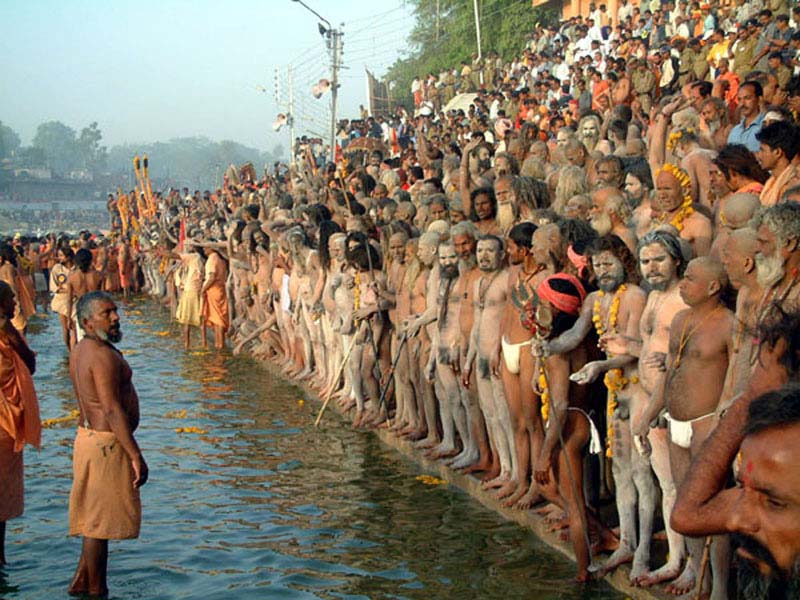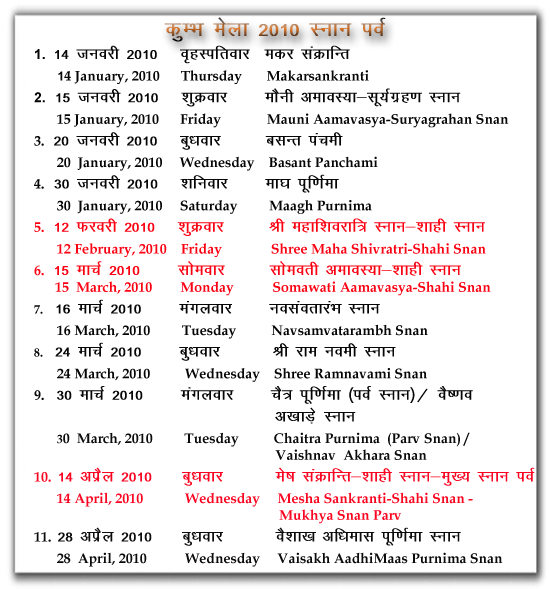 |

|
 |

|
 |
|
|
 Sacred site festivals in India, called melas, are a vital part of the pilgrimage tradition of Hinduism. Celebrating a mythological event in the life of a deity or an auspicious astrological period, the melas attract enormous numbers of pilgrims from all over the country. The greatest of these, the Kumbha Mela, is a riverside festival held four times every twelve years, rotating between Allahabad at the confluence of the rivers Ganges, Yamuna and the mythical Saraswati, Nasik on the Godavari, Ujjain on the Sipra, and Hardwar on the Ganges. Bathing in these rivers during the Kumbha Mela is considered an endeavour of great merit, cleansing both body and spirit. The Allahabad and Hardwar festivals are routinely attended by five million or more pilgrims (13 million visited Allahabad in 1977 and over 18 million in 1989) thus the Kumbha Mela is the largest religious gathering in the world. It may also be the oldest. Two traditions are in circulation regarding the origin and timing of the festival: one that stems from ancient texts known as the Puranas, and the other that connects it with astrological considerations. According to the Puranic epic, the gods and demons had churned the milky ocean at the beginning of time in order to gather various divine treasures including a jar containing a potion of immortality. As the jar emerged from the ocean the gods and demons began a terrific battle for its possession. During the battle, which according to some legends the gods won by trickery, four drops of the precious potion fell to earth  |
 |
These places became the sites of the four Kumbha Mela festivals. The astrological tradition (ascribed to a lost Puranic text and not traceable in extant editions) seems to stem from a very ancient festival called the Kumbha Parva, which occurred at Hardwar every twelfth year when Jupiter was in Aquarius and the sun entered Aries. At some later time the term 'Kumbha' was prefixed to the melas held at Nasik, Ujjain and Prayaga (the earlier name of Allahabad), and these four sites became identified with the four mythical locations of the immortality potion. In theory the Kumbha Mela festivals are supposed to occur every three years, rotating between the four cities. In practice the four-city cycle may actually take eleven or thirteen years and this because of the difficulties and controversies in calculating the astrological conjunctions. Furthermore the interval between the Kumbha Mela at Nasik and that at Ujjain is not of three years; they are celebrated the same year or only a year apart. This deviation in practice is intriguing and cannot be fully explained by either astrological or mythological means. The following chart gives the astrological periods of the four melas, and the years of their most recent and near future occurrences.
Hardwar.........when Jupiter
is in Aquarius and the Sun is in Aries during the Hindu month of Caitra
(March-April); 1986, 1998, 2010, 2021.
Allahabad....... when Jupiter
is in Aries or Taurus and the Sun and Moon are in Capricorn during the
Hindu month of Magha (January-February); 1989, 2001, 2012, 2024.
Nasik..............when
Jupiter and the Sun are in Leo in the Hindu month of Bhadrapada (August-September)
1980, 1992, 2003, 2015.
Ujjain..............when
Jupiter is in Leo and the Sun is in Aries, or when Jupiter, the Sun, and
the Moon are in Libra during the Hindu month of Vaisakha (April-May) 1980,
1992, 2004, 2016.
The antiquity of the Kumbha Mela is shrouded in mystery. The Encyclopaedia Britannica states that the Chinese Buddhist pilgrim, Hsuan Tsang, recorded a visit to the Allahabad Kumbha Mela in the 7th century AD in the company of the King Harsavardhana but this is inaccurate information.
Hsuan Tsang did actually attend a festival with this king at Allahabad in the 7th century but his records give no mention of a fair called Kumbha and thus the Encyclopedia Britannica assertion is nothing but conjecture.
| Tradition credits the ninth
century philosopher Sankaracharaya with the organization of the Kumbha
Mela at Prayaga (Allahabad). Sankaracharaya had established four monasteries
in the north, south, east and west of India, and had called upon the yogis,
sadhus and sages to meet at these sites for an exchange of philosophical
views. These sites in the four cardinal directions were separated by great
distances however, and thus the more centrally located site of Prayaga
became the meeting place of choice. Indologists speculate that during the
9th to 12th centuries other monks and religious reformers perpetuated and
reinforced this periodic assemblage of saints and householders at sacred
places on the banks of the holy rivers to create an environment of mutual
understanding amongst different religious sects. Additionally the festival
gave householders the opportunity to derive benefit from their association
with the normally reclusive sages and forest yogis. What was originally
a regional festival at Prayaga thus became the pre-eminent pan-Indian pilgrimage
site.
While many millions of Indians, male and female, young and old, lay person and monk, will visit the Allahabad Kumbha Mela, the festival is traditionally known as the mela of the ascetics and sadhus. At the most auspicious hour on the most auspicious day of the month-long festival many thousands of naked holy men from various sects will immerse themselves in the river for a ceremonial bath. Furthermore it is important to note that many Hindus consider the Kumbha Mela sites to be the most favoured places at which to die, and ritual suicide, though discouraged by the government, is still practiced. Westerners are bewildered, even shocked, by this matter and frequently make insolent judgments without understanding the mythological, religious, and cultural reasons behind the behaviour. While it is beyond the scope of this present book to discuss the subject in adequate detail, it is interesting to focus attention upon the two origin myths of the Kumbha Mela festival. Four drops of a nectar or potion of immortality were supposed to have fallen to earth at these sites, and at particular astrological periods the four sites are believed to function as portals into immortality and everlasting union with god. How did such myths arise and what is the message encoded in them? Perhaps there is some energy, some mysterious spirit or power, manifest at these places and times that somehow allows or assists intentful human beings to more fully experience spiritual immortality and divinity. The fact that hundreds of millions of people (coming from the most ancient and sophisticated philosophical and metaphysical systems on earth) have for thousands of years believed this to be true suggests that an awesome power is indeed present at the Kumbha Mela sites. |
| Privacy Policy for LiveIndia.Com |